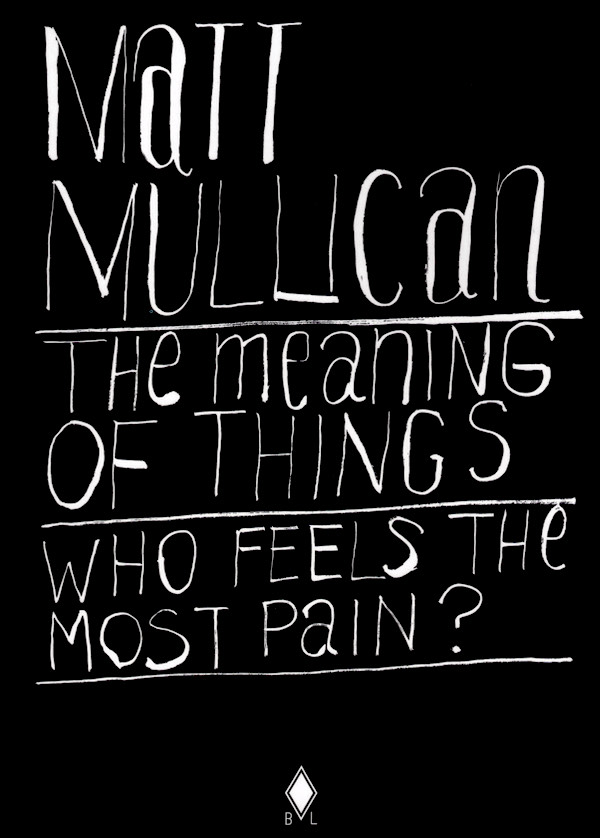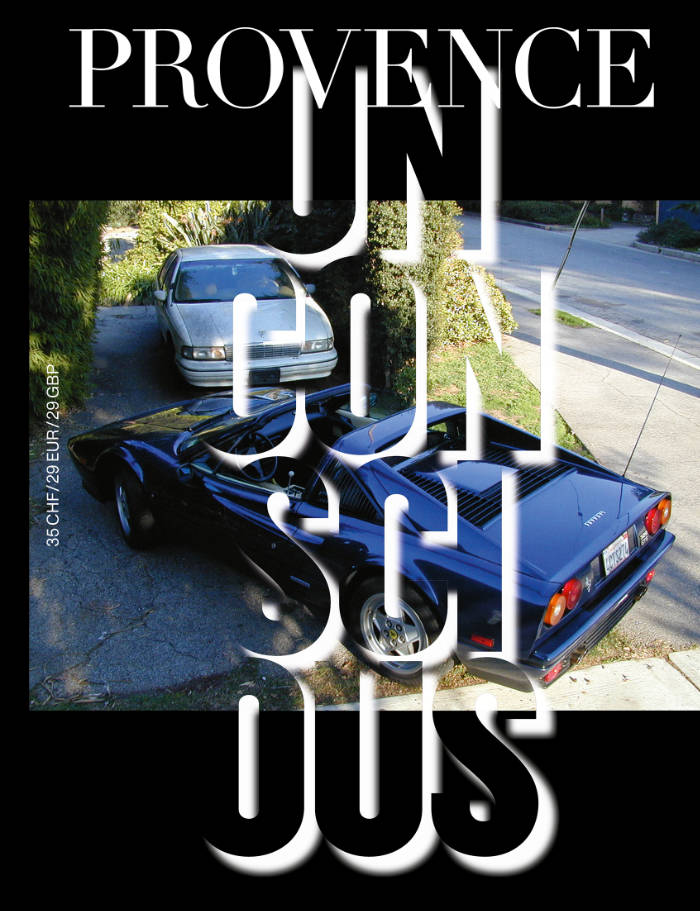Matt Mullican
Matt Mullican

Rubbings Catalogue 1984-2016
One of Matt Mullican's central and most consequential inventions, the so-called “Rubbings,” are a kind of “frottages,” a technique the artist uses to produce specific pictures. The book presents a catalogue of the Rubbings on canvas from 1984 to 2015. It comprises around 500 works, documented by images and catalogue entries (the book also contains an essay by Dieter Schwarz).
From the beginning of his career, Mullican looked for pictures that would not be paintings; thus, he used banners, the traditional carriers of signs, posters, and, in 1984, he realized his first Rubbing. He used a cardboard plate on which the canvas was placed; by rubbing with an oil stick the cardboard reliefs, forms became visible on the canvas. This way, Mullican was able to transfer complex representations onto canvas; the result is a picture of something that is not present, it is a form of copy. The cardboard plates may be used for other works and so the imagery can reappear in different configurations. Each Rubbing is a single work and at the same time a reproduction, like a print, part of a sequence which contains picture elements from different sources.
Following the Rubbings from 1984 to recent times, it becomes visible that they represent the motives and themes the artist worked with over the years. The sequence of the Rubbings appears therefore like a diary of Mullican's work.
Published on the occasion of the exhibition “Nothing Should Exist” at Kunstmuseum Winterthur, Switzerland, from June 11 to October 16, 2016.
Working in the fields of performance, installation, digital technology and sculpture, Matt Mullican (born 1951 in Santa Monica, lives an works in New York) is seeking to develop a cosmological model based on a personal vocabulary combining the formal and the symbolic. Hypnosis and cartography are his principal modes of operation. He explores functional sign systems of his own devising through activities under hypnosis, in a permanent oscillation between the real and its schematization, between fiction and its physical reality.
Edited by Dieter Schwarz.
Text by Dieter Schwarz.
published in June 2016

The Meaning of Things (who feels the most pain?)
This artist's book is the book-form of a work by Matt Mullican, "The Meaning of Things (who feels the most pain?)" (2014), consisting of 676 collages and texts on sheets of standard printing paper.
At the approximate center of each collage is a small image that appears to be a printout of an image procured from the Internet. Around the images are hand-drawn, quasi-calligraphic marks (in black only), curved, giving the impression of an "organic" form in the manner of ornate, rococo frames. The series develops a narrative of interests, practices and collective representations that suggest and disavow each other. Mullican deftly challenges this simple to-and-froing of "virtual" and "real" by suspending the idea that only through the material/physical printing out of the digital images, the content of the images is "restored" back into the "real"—to grasp the "meaning of things" comes at the price of "feeling the most pain".
Working in the fields of performance, installation, digital technology and sculpture, Matt Mullican (born 1951 in Santa Monica, lives an works in New York) is seeking to develop a cosmological model based on a personal vocabulary combining the formal and the symbolic. Hypnosis and cartography are his principal modes of operation. He explores functional sign systems of his own devising through activities under hypnosis, in a permanent oscillation between the real and its schematization, between fiction and its physical reality.
And more

PROVENCE UNCONSCIOUS
PROVENCE UNCONSCIOUS deep dives into the cosmological pool that shapes the collective unconscious and takes a look at the relevance of Jung's ideas in relation to contemporary art and fashion.
PROVENCE UNCONSCIOUS draws inspiration from the Zurich-based office's proximity to the C.G. Jung Institute in Küsnacht—recently and notably visited by Pamela Anderson, who also appears in the publication. PROVENCE UNCONSCIOUS focuses on the work of three US-American artists—Mike Kelley, Matt Mullican, and Jason Rhoades—whose practices orbit around the themes of psychoanalysis and the unconscious. The issue also features collaged analog photographs of Laura Langer's spiral paintings, and a manuscript-style dream archive: over 30 hand-written or drawn submissions by artists, curators, jungians, and writers. Additional sections include, among many other things, jewelry by Bernhard Schobinger, photographs by Calla Henkel and Max Pitegoff, and a curatorial exploration of Emma Jung—analyst and wife of C.G. Jung—shedding light on the often-overlooked feminine legacy within Jungian thought.
PROVENCE UNCONSCIOUS didn't include any cooking recipes. And no, PROVENCE is not a magazine—but if it were, it would probably be the most radical one among its contemporary art peers.
Edited by Tobias Kaspar, Paolo Baggi, Samuel Haitz, Nina Hollensteiner, Claire Shiying Li, Veronika Dorosheva, Tatjana Hub.
Contributions by Pamela Anderson, Nina Hollensteiner & Claire Shiying Li, Forrest Bess, Matt Mullican, Mike Kelley, Valerie Smith, Delcy Morelos, Jimmy Raskin, Petra von bechtolsheim, Elizabeth leuenberger, Laura Langer, Bernhard Schobinger, Sophie Gogl, Susan Hiller, Calla & Max Pitegoff, Emma Jung, Rebecca Ackroyd, Korakrit Arunanondchai, Claire Shiying Li, Séverine Heizmann, Olga Fröbe-Kapteyn, Raphael Gygax, Stefano Carpani, Sabrina Tarasoff lITeRaTURe, Leda Bourgogne, Olamiju Fajemisin, Veronika Dorosheva, Lera Polivanova, Edgars Gluhovs.

Artistes typographes
Artistes typographes (Artists as typographers) is a visual corpus that brings together one hundred and thirty-two artists' books collected and reproduced as part of an artistic residency conducted at the Centre des livres d'artistes (Saint-Yrieix-la-Perche). This compilation of images demonstrate the interest of some figures of the art field for the substances of the book object. They show singular compositions and other typographic details: handwritten letters, character designs, stamps, logotypes.
Featuring Jean-Michel Alberola, John Baldessari, Christian Boltanski, Jean-François Bory, Broutin, Pol Bury, Philippe Cazal, Ulises Carrión, Henri Chopin, Claude Closky, Joëlle de la Casinière, herman de vries, Hamish Fulton, Jochen Gerz, Raoul Hausmann, Simone Forti, Paul-Armand Gette, Dick Higgins, Isidore Isou, Joseph Kosuth, Edmund Kuppel, La Monte Young, Pascal Le Coq, Jean Le Gac, Lefevre Jean Claude, Claude Lévêque, Mario Merz, Annette Messager, Jean-Claude Moineau, Matt Mullican, Maurizio Nannucci, Clemente Padín, Dieter Roth, Claude Rutault, Seth Siegelaub, Roman Signer, Harald Szeemann, Ernest T., Ben Vautier, Bernard Villers, Wolf Vostell, Martha Wilson...

Matt Mullican’s Pure Projection Landscapes
Since the late 1970s Matt Mullican has developed a practice of performing under hypnosis that extends from his investigations into representation and subjective projection, and from his efforts to “enter the image” and embody a fictional character, a body of work that offers an exceptional perspective on repetition and renewal in performance practice.
This book is the outcome of an extensive research project into Mullican’s hypnosis performances, undertaken within the frame of If I Can’t Dance’s Performance in Residence programme with invited researcher Vanessa Desclaux, and a two-day Class of Masters with Mullican on character construction. Desclaux takes up the question of personification in light of her analysis of Mullican’s hypnosis performances. A selection of Mullican’s photographs and works on paper are reproduced in this book.

Success in Failure
First monograph devoted to the work of video artist and performer Wolfgang Stoerchle (1944-1976), an artistic figure of the Californian scene in the 1970s, based on extensive research and three international exhibitions.
Wolfgang Stoerchle is a particularly notable artistic figure of the early seventies who left a certain but little advertised mark on a generation of Californian artists, especially through videotapes and performances involving his body as raw material. His short but eventful life is surrounded by rumors, and his abrupt death in 1976 may have emphasized the myth around him even more. His entire body of work was produced in eleven years, between 1965 and 1976. Forty-five years after he passed away, his name still drifts across the West Coast art world, awaiting wider recognition.
Wolfgang Stoerchle: Success in Failure is the first monograph on the artist's work, written by Alice Dusapin who has dedicated extensive research into his life and work since 2017 and organized several international exhibitions during this time (Ampersand, Lisbon; Gallery Overduin & Co, Los Angeles; Gallery Air de Paris and Museum of Contemporary Art of Rome).
The publication includes interviews with Daniel Lentz, Paul McCarthy, Matt Mullican, David Salle, Helene Winer, and an unpublished review by James Welling, alongside ephemera and documentation of Stoerchle's video works and performances, as well as rarely seen sculptures, installations, and paintings.
Edited by Alice Dusapin, with Justin Jaeckle.
Texts by Alice Dusapin and James Welling; interviews with David Salle, Helene Winer, Matt Mullican, Paul McCarthy, Daniel Lentz.